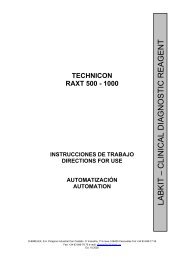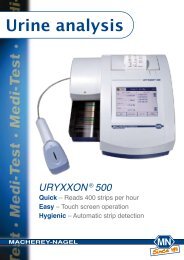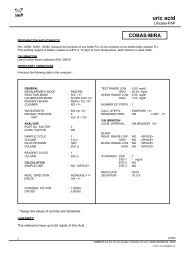[Protein C antigen rocket]. - Agentúra Harmony vos
[Protein C antigen rocket]. - Agentúra Harmony vos
[Protein C antigen rocket]. - Agentúra Harmony vos
Create successful ePaper yourself
Turn your PDF publications into a flip-book with our unique Google optimized e-Paper software.
PROTEIN C ROCKET EID<br />
2. Dilute each patient sample and control with 0.85% saline. Prepare a 1:2 dilution (1 part patient<br />
sample and 1 part saline) and a 1:4 dilution (1 part patient plasma and 3 parts saline). Additional<br />
dilutions may be necessary depending on the patient history. Suspected abnormal samples may<br />
need to be tested undiluted.<br />
3. Preparation:<br />
If using Zip Zone Chamber: Pour 200ml of Tris-tricine Buffer into each of the outer sections of<br />
the chamber (requires a total of 400ml buffer) and place one sponge wick in the buffer along each<br />
inner wall of the chamber.<br />
If using TITAN GEL Chamber: Pour 65ml Tris-tricine buffer into each inner section of the<br />
chamber.<br />
4. Remove any excess buffer from the wells of the plate. NOTE: Excess moisture on the plate can<br />
result in poor <strong>rocket</strong>s.<br />
5. Apply 10µl of each dilution of the patient samples and controls to the designated wells.<br />
NOTE: Standard curve samples must be run on each plate. Duplicate applications of patient<br />
samples are advisable. When applying the samples to the plate wells, do not allow the pipette tip<br />
to touch the sides of the wells as this may cause damage.<br />
6. Allow 5 minutes for specimens to diffuse into the agarose.<br />
7. Electrophoresis:<br />
If using Zip Zone Chamber: Place the plate, agarose side down, into the chamber on the sponge<br />
wicks. Place the application point (wells) toward the cathode (negative) side of the chamber.<br />
If using TITAN GEL Chamber: Place the plate into the inner section of chamber, agarose side<br />
down, by gently squeezing the gel into place. Position the gel(s) so that the edges of the agar are<br />
in the buffer and the wells are toward the cathode (-) side of the chamber.<br />
8. Electrophorese the plates at a constant current of 16mA per plate for 3 hours.<br />
9. Following electrophoresis, remove the plates from the chamber. Discard the chamber buffer after<br />
each run. NOTE: Use the TITAN GEL Multi-Staining Set (Cat. No. 1558) as a staining and rinsing<br />
chamber.<br />
10. Rinse the plate with deionized or distilled water and wash it in 0.85% saline overnight with gentle<br />
stirring.<br />
11. Following the overnight wash, rinse the plate with deionized or distilled water.<br />
12. Place the plate on a flat surface, agarose side up. Cover the agarose with a single, lint-free tissue.<br />
13. Place 2-3 Blotter Pads and a Development Weight on the plate for 15 minutes and remove.<br />
14. Dry the plate in a drying oven at 60...70°C for 10-20 minutes. DO NOT over dry plates.<br />
The plate will be transparent when completely dry. NOTE: If a dryer/oven is not available, the<br />
plates may be covered with wet lint-free tissues and allowed to dry at 15...30°C overnight or under<br />
a fan for 3 hours at 15...30°C as climate requires.<br />
15. Following drying, stain the plate by immersing it in Rocket Stain for 20 minutes.<br />
16. Place the plate in destain solution for 1-3 minutes. NOTE: Destaining is complete as soon as the<br />
background sufficiently clears in order to easily distinguish <strong>rocket</strong> peaks. NOTE: Excessive<br />
destaining may fade the <strong>rocket</strong>s making correct measurements difficult. If over destaining does<br />
occur, repeat Step F.7. and stain the <strong>rocket</strong>s again.<br />
17. Rinse the plate twice in purified water for 5-10 minutes each rinse.<br />
18. Dry the plates at 37°C for 5 minutes or at 15...30°C until dry.<br />
3<br />
English


![[Protein C antigen rocket]. - Agentúra Harmony vos](https://img.yumpu.com/37734752/5/500x640/protein-c-antigen-rocket-agentara-harmony-vos.jpg)
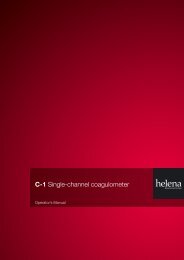
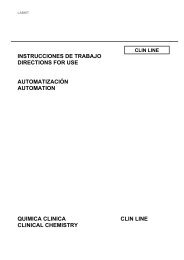
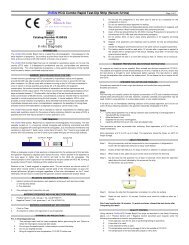
![[APTT-SiL Plus]. - Agentúra Harmony vos](https://img.yumpu.com/50471461/1/184x260/aptt-sil-plus-agentara-harmony-vos.jpg?quality=85)


![[SAS-1 urine analysis]. - Agentúra Harmony vos](https://img.yumpu.com/47529787/1/185x260/sas-1-urine-analysis-agentara-harmony-vos.jpg?quality=85)


![[SAS-MX Acid Hb]. - Agentúra Harmony vos](https://img.yumpu.com/46129828/1/185x260/sas-mx-acid-hb-agentara-harmony-vos.jpg?quality=85)

